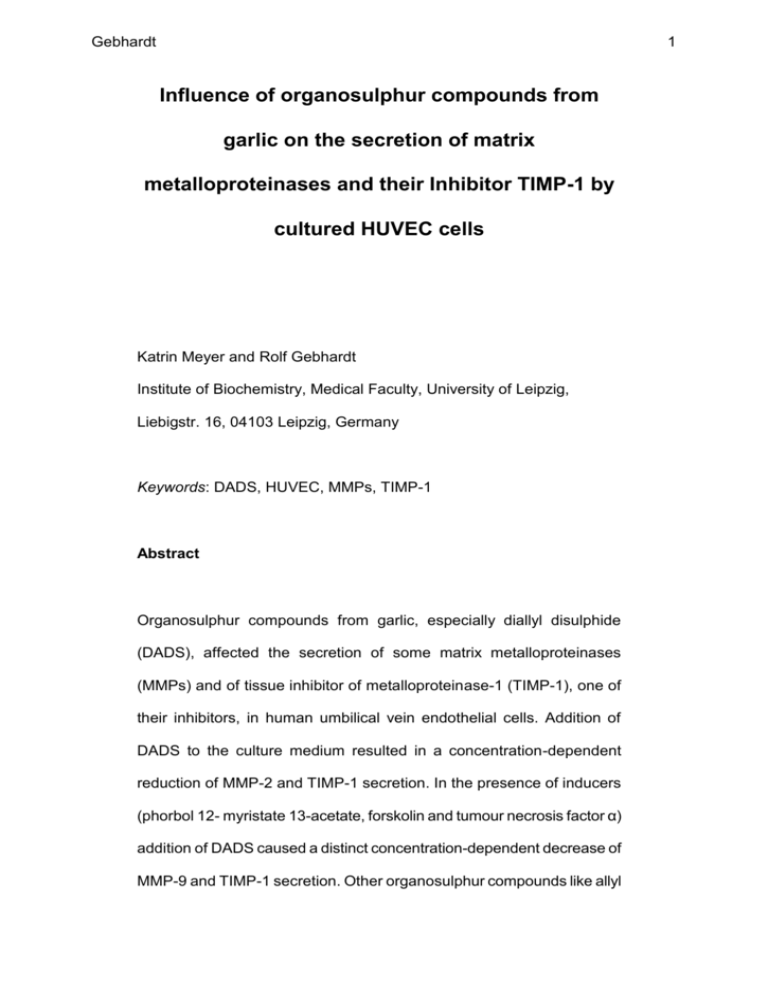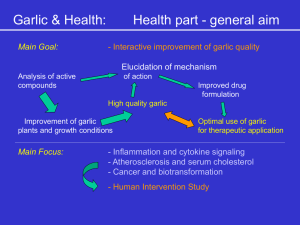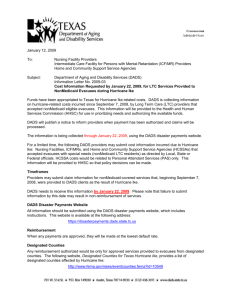Cell Cultures - Plant Research International
advertisement

Gebhardt 1 Influence of organosulphur compounds from garlic on the secretion of matrix metalloproteinases and their Inhibitor TIMP-1 by cultured HUVEC cells Katrin Meyer and Rolf Gebhardt Institute of Biochemistry, Medical Faculty, University of Leipzig, Liebigstr. 16, 04103 Leipzig, Germany Keywords: DADS, HUVEC, MMPs, TIMP-1 Abstract Organosulphur compounds from garlic, especially diallyl disulphide (DADS), affected the secretion of some matrix metalloproteinases (MMPs) and of tissue inhibitor of metalloproteinase-1 (TIMP-1), one of their inhibitors, in human umbilical vein endothelial cells. Addition of DADS to the culture medium resulted in a concentration-dependent reduction of MMP-2 and TIMP-1 secretion. In the presence of inducers (phorbol 12- myristate 13-acetate, forskolin and tumour necrosis factor α) addition of DADS caused a distinct concentration-dependent decrease of MMP-9 and TIMP-1 secretion. Other organosulphur compounds like allyl Gebhardt 2 mercaptan and S-allylcysteine showed a less clear effect on MMP- or TIMP-1-secretion. All tested substances seemed to be toxic at high concentrations only. These results suggest that DADS, through shifting the MMP-TIMP balance, might mediate some of the effects ascribed to garlic preparations. Abbreviations: AM, allyl mercaptan; AMS, allyl methyl sulphide; DADS, diallyl disulphide; HUVEC, human umbilical vein endothelial cells; ELISA, enzyme linked immuno sorbent assay; MMP, matrix metalloproteinase; MTT, 3-[4,5-dimethylthiazol-2yl]-2,5-diphenyl tetrazolium bromide; PMA, phorbol 12- myristate 13-acetate; SAC, S-allylcysteine; TIMP, tissue inhibitor of metalloproteinases; TNFα, tumour necrosis factor α Introduction Matrix metalloproteinases (MMPs) are a family of zinc-dependent proteinases involved in extracellular matrix degradation (Nagase and Woessner, 1999; Benjamin, 2001). The balance between these proteinases and their specific inhibitors (TIMPs) is thought to play an important role in tissue remodelling and pathogenesis of many diseases (e.g. angiogenesis, arthritis, atherosclerosis, metastasis and fibrosis) (Brew et al, 2000; Galis and Khatri, 2002; Luttun et al, 2000; Gomez et al, 1997). Concerning the physiology and pathology of the vascular system, MMPs and TIMPs produced by endothelial cells are of particular Gebhardt interest (Luttun et al, 2000; van Hinsbergh, 1992; Kunz, 2002; Loftus et al, 2002). Depending on the type of tissue, endothelial cells express a distinct set of these proteinases and inhibitors that can be modulated by cytokines and other signals (Hanemaaijer et al, 1993). Because of the importance of MMPs for pathological events, agents that may affect their expression or activity are currently discussed and developed as possible drugs for the treatment of some of these diseases (George, 2000; Celentano and Frishman, 1997; Demeule et al, 2000). Accumulating evidence suggests that garlic consumption may improve the health status in many types of disease including atherosclerosis (Reuter et al, 1996; Orekhov and Grunwald, 1997). Among the many components of garlic, the organosulphur compounds are believed to show an antiatherosclerotic potential (Amagase et al, 2001; Lawson, 1998). In addition, interference with hepatic cholesterol biosynthesis was demonstrated using rat hepatocytes and human Hep G2 cells (Gebhardt et al, 1994). However, although several reports have added details about possible molecular mechanisms of the organosulphur compounds (Gebhardt 1997b, Gebhardt and Beck, 1996; Gebhardt, 1995), the complex interactions with various physiological and pathological cellular processes are far from being understood. Furthermore, aspects of the bioavailability and biotransformation of these compounds have to be taken into account. Though allicin is the first product formed by alliinase, it is doubtful whether allicin occurs in systemic blood, because it is highly reactive. On the other hand, there is evidence suggesting that diallyl disulphide (DADS) and allyl mercaptan (AM) represent intermediates 3 Gebhardt with detectable concentrations in peripheral blood (Germain et al., 2002). In the present study, we have investigated whether some of these more stable organosulphur compounds derived from garlic are able to interfere with the secretion of MMPs and of TIMP-1 by human umbilical vein endothelial cells (HUVEC). Materials and methods Materials William’s E medium was purchased from Bio Whittaker (Verriers, Belgium), foetal calf serum and accutase were from PAA Laboratories (Linz, Austria), glutamine from Merck (Darmstadt, Germany), HUVEC, Medium 200 and its supplements were from TEBU GmbH (Frankfurt, Germany), trypsin and tumour necrosis factor α (TNFα) were obtained from Boehringer-Mannheim (Mannheim, Germany), dimethyl sulfoxide (DMSO) was from Carl Roth GmbH+Co (Karlsruhe, Germany), penicillin, streptomycin, phorbol 12- myristate 13-acetate (PMA), forskolin and 3[4,5-dimethylthiazol-2yl]-2,5-diphenyl tetrazolium bromide (MTT) reagent were purchased from Sigma-Aldrich Chemie GmbH (Taufkirchen, Germany). AM was obtained from Aldrich Chemical Co. Ltd (Gillingham, England), allyl ethyl ether and allyl methyl sulphide (AMS) were from Lancaster Synthesis Ltd. (Morecambe, England). Culture flasks, 6-well plates and other cell culture material were purchased from TPP Techno Plastic Products (Trasadingen, Switzerland). Enzyme linked immuno sorbent assay (ELISA) and activity assay test systems were obtained 4 Gebhardt from Amersham Pharmacia Biotech (Buckinghamshire, England). DADS and S-allylcysteine (SAC) were supplied by Jacques Auger (Tours, France) Cell Cultures HUVEC were maintained in 75 cm² culture flasks at 37°C under an atmosphere of 5% CO₂ and 95% air in a mixture of 2 different media containing 80% (v/v) William’s E supplemented with 10% (v/v) heatinactivated foetal calf serum, 2 mmol/l glutamine, penicillin (50U/ml) and streptomycin (50µg/ml) and 20% (v/v) Medium 200 supplemented with low serum growth supplements consisting of 2% (v/v) foetal bovine serum, 1.5 µg/ml basic fibroblast growth factor, 5 mg/ml heparin, 100 µg/ml BSA, 1 mg/ml hydrocortisone, 5 µg/ml human epidermal growth factor, penicillin G (100 U/ml), streptomycin sulphate (100µg/ml) and amphotericin B (0.25µg/ml). In 75 cm² flasks 15 ml of the medium mixture were used, in 6-well plates cells were grown in 1 ml of the medium mixture per well. Culture medium was replaced every second day. When confluent monolayers were reached, cells were detached by either trypsin or accutase and seeded into new flasks or 6-well plates at a density of about 2500 cells/cm². Incubation of the cell cultures with organosulphur compounds from garlic For experiments, cultures were used between passages 4 and 15, reaching about 80% confluency in 6-well plates. DADS, AM and SAC were dissolved in DMSO or medium and diluted by fresh medium to 5 Gebhardt concentrations reaching from 0.2 to 500µM. The concentration of DMSO in the medium was adjusted to 0.91% in each case. Diluted substances were added to the cell cultures during a 9 h or 24 h incubation period. For stimulation of some MMPs and TIMP-1, 10 nM PMA, 25µM forskolin and 10 ng/ml TNFα were added to the medium during the 9 h or 24 h incubation period according to Hanemaaijer et al. (1993). Analytical procedures Conditioned medium was collected from 6-well plates after an incubation period of 9 h or 24 h and centrifuged for 5 min at 13000 g to remove cells and debris. Most samples were used freshly, only some were frozen at – 20°C until use. In some cases samples were diluted 1:4 – 1:10 with assay buffers from the ELISA or activity assay test kit. Secretion of individual MMPs and TIMP-1 was determined by ELISA and activity assay techniques. Respective assays for MMP-1, -2, -3, -8, -9, and -13 ELISA, TIMP-1 ELISA and MMP-2 and –9 activity assay were performed exactly according to the manufacturer’s recommended procedure. In case of activity assays, MMPs were further activated during the test procedure by adding p-aminophenylmercuric acetate. Experiments were calibrated using internal and external standards. Each concentration of test substances was measured in two, in some cases in up to eleven different wells. Toxicity studies Cytotoxicity of DADS, AM and SAC was determined by MTT cytotoxicity 6 Gebhardt 7 assay. The assay was carried out according to Gebhardt (1997a) with the following modifications: After the 9 h or 24 h incubation period, the medium was discarded and 600µl of fresh medium were added to each well of 6-well plates containing 0.5 mg/ml MTT reagent. After an incubation period of further 2 h medium was replaced by 800 µl DMSO for dissolving the formazane produced. The absorbance at 590 nm was read immediately with a Tecan Spectra Fluor spectrophotometer. Additionally, lactate dehydrogenase leakage assay was performed as described (Gebhardt and Fausel, 2000). Statistical analysis All measurements were performed at least in duplicate. Data are expressed as mean ± range. EC50 values were determined by curve fitting analysis using Origin software on a PC. Results Cytotoxicity In order to evaluate cytotoxic effects of garlic organosulphur compounds on HUVEC cells, MTT cytotoxicity assays were performed with DADS, AM and SAC. In HUVEC stimulated with PMA, forskolin and TNFα, no cytotoxicity could be shown for DADS after a 24 h incubation period, except for the highest concentration (500µM) where a slight reduction could be observed (Fig. 1). AM and SAC seemed to be even less toxic. In non-stimulated cells, results were not as clear as in stimulated due to Figure 1 Gebhardt 8 large variations between different cultures. Nevertheless, after 9 h of incubation they likewise suggest DADS (Fig. 1), AM and SAC (not shown) to be non-cytotoxic and to affect cells only marginally at high concentrations. Using lactate dehydrogenase leakage assays, similar results were obtained (not shown). Secretion of MMPs and TIMP-1 HUVEC were found to express and secrete mainly MMP-1, MMP-2 and TIMP-1. After an incubation period of 9 h on average about 58 ng/ml of MMP-1 (Fig. 2), 16 ng/ml of MMP-2 (not shown) and 44 ng/ml of TIMP-1 (Fig. 2) were secreted by the HUVEC. Treatment with PMA, forskolin and TNFα for 9 h clearly enhanced the secretion of MMP-1 and TIMP-1 about 2.6- or 3.9-fold respectively (Fig. 2). A possible enhancement of MMP-2 was not tested. While MMP-3 and MMP-9 secretion were not detectable by ELISA (the detection limit was 2.5 ng/ml for MMP-3 and 0.5 ng/ml for MMP-9) in the basal state, about 14 ng/ml MMP-3 and 2 ng/ml MMP-9 were secreted after stimulating the cells with PMA, forskolin and TNFα for 24 h. However, especially for MMP-9 the secretion rate considerably differed in different subcultures. Cultures from lower passage numbers usually secreted more MMP-9 (not shown). Similar to that, secreted MMP-9 activity measured by activity assay also varied a lot with values of about 5 ng/ml in average after 24 h of incubation including stimulants (not shown). The differences between the two assays may be due to the fact that the ELISA mostly detects pro-MMP-9, while the activity assay Figure 2 Gebhardt 9 additionally detects activated MMP-9. Because of further activation of the pro-MMP-9 during the activity assay procedure, all pro and active forms of MMP-9 could be detected by the activity assay. In contrast to the others, MMP-8 and MMP-13 secretion was never detectable after 9 h or 24 h of incubation with or without stimulation (the detection limit was 0.2 ng/ml for MMP-8 and 0.1 ng/ml for MMP-13) (not shown). In general, the amount of the MMPs secreted by the HUVEC increased with time up to at least 24 h (not shown). Effects of DADS, AM and SAC on MMP- and TIMP-Secretion Addition of DADS to the culture medium resulted in a slight Figure 3 concentration-dependent reduction of secreted MMP-2 activity starting above 10 μM and leading to a loss of approx. 30% at 500 µM after 9 h of incubation. AM and AMS showed no reducing effect up to 500 µM (Fig. 3). The structural analogues, SAC and allyl ethyl ether, were also without effect (not shown). Similar results were obtained with a specific ELISA for MMP-2 after 9 h of cultivation (data not shown). Using an activity assay for MMP-9 the DADS concentration-dependent Figure 4 diminution of enzyme activity secreted by HUVEC after stimulation with PMA, forskolin and TNFα was also evident after 24 h (Fig. 4). Diminution started at a DADS concentration above 32 µM with an apparent EC-50 value of 65 µM. The MMP-9 ELISA showed similar results with a reduction of MMP-9 secretion by DADS starting above 8 µM with an apparent EC-50 value of 24 µM (Fig.5). In the activity assay, AM and SAC did not show any reduction, whereas in the ELISA a slight reduction Figure 5 Gebhardt 10 of MMP-9 secretion seemed to occur at the highest concentration (Fig. 4 and 5). In contrast to MMP-2 and -9, secretion of MMP-1 was not effected by DADS, AM or SAC in basal cultivation. Even after stimulation of the HUVEC, no reducing effect on MMP-1 secretion was detectable below a DADS concentration of 500 µM after 9 h of incubation (data not shown). Likewise, neither DADS, nor AM or SAC reduced MMP-3 production of HUVEC stimulated with PMA, forskolin and TNFα for 24 h (data not shown). On the other hand, DADS not only influenced production of certain MMPs, it also reduced the secretion of TIMP-1 (Fig. 6). The most prominent effect of DADS could be observed in stimulated cells, characterized by a reduction of TIMP-1 secretion above 16 µM with an EC-50 value of about 75 µM. Non-stimulated HUVEC reacted only in a moderate DADS concentration-dependent TIMP-1 decrease starting above 50 µM and leading to a maximal reduction by 22-37% (Fig.6). Again, AM and SAC showed no effect, neither in stimulated HUVEC (Fig. 6), nor in non-stimulated cells (data not shown). Discussion The present study describes two main results: (a) cultured HUVEC secrete a distinct set of MMPs and TIMP-1 which is altered in response to a cocktail of stimulating signals and (b) DADS is the only of the tested organosulphur compounds able to downregulate selective members of Figure 6 Gebhardt the secreted proteases or the inhibitor in the basal as well as in the induced state. Concerning induction of MMP and TIMP secretion, several signalling pathways seem to be important, as all three stimuli, PMA, forskolin and TNFα, together enhanced the secretion. PMA is a potent activator of protein kinase C (Liu and Heckman, 1998), forskolin enhances cyclic AMP (Chabardès et al, 1999) and TNFα is a very important inflammatory mediator acting through NF-ĸB (Hehlgans and Männel, 2002). Obviously, these signals induce only a specific set of proteases that seems to be characteristic of HUVEC. In accordance, Hanemaaijer et al. (1993) showed that the three single substances variously influence different MMPs and TIMPs in different cells. The fact that only DADS interfered with the secretion of MMPs and of TIMP-1 is remarkable from several points of view. Firstly, secretion by HUVEC is much more sensitive to DADS than any cytotoxic response. Secondly, there is a structural aspect. The comparison with some structural analogues suggests that the disulphide bond and/or two allylgroups are necessary for interference. Of course, additional experiments are needed to define the exact structural requirements as well as the mode of action. Nonetheless, it is interesting that AM is inactive, although it has been shown in several studies to mimic effects of DADS at least at higher concentrations (Gebhardt and Beck, 1996). Thirdly, the influence of DADS seems very specific manifesting only on a subset of MMPs and on TIMP-1. This again raises the question of the molecular mechanisms behind this effect as interference seems not coupled to inducibility. On the other hand, it indicates that DADS may change the 11 Gebhardt balance between MMPs and inhibitors in endothelial cells independent of their state of activation. Finally, DADS is derived from allicin, the product formed from the genuine garlic compound alliin under conditions of an active alliinase, while SAC is found in ethanol treated garlic preparations only (Yeh and Liu, 2001). Our results demonstrate that SAC, in contrast to DADS, does not show any influence on MMP and TIMP secretion indicating that physiological effects may depend on the type of garlic material consumed. Together, these findings add new aspects to the possible role of garlic in health and disease. The ability of a garlic derived organosulphur compound to modulate the balance between MMPs and TIMPs renders it possible that garlic consumption affects the breakdown of extracellular matrix in or around blood vessels. Since matrix deposition and disruption are fundamental aspects of arteriosclerosis and plaque rupture (Shah, 2000; Galis and Khatri, 2002; Ye et al, 1998), it seems worth to further investigate the influence of garlic consumption on these processes in diseased states. Acknowledgements The authors would like to thank F. Struck and Dr. F. Gaunitz for technical assistance. This work was supported by a grant (QLK1-CT-1999-00498) from the European Commission. 12 Gebhardt 13 References Amagase H, Petesch BL, Matsuura H, Kasuga S, Itakura Y. Intake of garlic and its bioactive components. J Nutr. 2001; 131: 955S-962S. Benjamin IJ. Matrix metalloproteinases: from biology to therapeutic strategies in cardiovascular disease. J Investig Med. 2001; 49: 381397. Brew K, Dinakarpandian D, Nagase H. Tissue inhibitors of metalloproteinases: evolution, structure and function. Biochim Biophys Acta. 2000; 1477: 267-283. Celentano DC and Frishman WH. Matrix metalloproteinases and coronary artery disease: a novel therapeutic target. J Clin Pharmacol. 1997; 37: 991-1000. Chabardès D, Imbert-Teboul M, Elalouf J-M. Functional properties of Ca²⁺ inhibitable type 5 and type 6 adenylyl cyclases and role of Ca²⁺ increase in the inhibition of intracellular cAMP content. Cell Signal. 1999; 11: 651-663. Demeule M, Brossard M, Pagé M, Gingras D, Béliveau R. Matrix metalloproteinase inhibiton by green tea catechins. Biochim Biophys Acta. 2000; 1478: 51-60. Galis ZS and Khatri JJ. Matrix metalloproteinases in vascular remodeling and atherogenesis: the good, the bad, and the ugly. Circ Res. 2002; 90: 251-262. Gebhardt R, Beck H, Wagner KG. Inhibition of cholesterol biosynthesis by allicin and ajoene in rat hepatocytes and HepG2 cells. Biochim Gebhardt 14 Biophys Acta 1994; 1213: 57-62. Gebhardt R. Amplification of palmitate-induced inhibition of cholesterol biosynthesis in cultured rat hepatocytes by garlic-derived allylthiosulfinates. Phytomedicine 1995; 2: 29-34. Gebhardt R and Beck H. Differential inhibitory effects of garlic-derived organosulfides on cholesterol biosynthesis in primary rat hepatocyte cultures. Lipids 1996; 31: 1269-1276. Gebhardt R. Antioxidative and protective properties of extracts from leaves of the artichoke (Cynara scolymus L.) against hydroperoxideinduced oxidative stress in cultured rat hepatocytes. Toxicol Appl Pharmacol. 1997a; 144: 279–286. Gebhardt R. Garlic: The key to sophisticated lowering of hepatocellular lipid. Nutrition 1997b; 13: 379-380. Gebhardt R and Fausel M. Inactivation of lactate dehydrogenase during freezing in the presence of methyrapone: implications for in vitro cytotoxicity studies. In Vitro Mol Toxicol. 2000; 13: 213-218. George SJ. Therapeutic potential of matrix metalloproteinase inhibitors in atherosclerosis. Exp Opin Invest Drugs. 2000; 9: 993-1007. Germain E, Auger J, Ginies C, Siess MH, Teyssier C. In vivo metabolism of diallyl disulfide in the rat: identification of two new metabolites. Xenobiotica 2002; 32: 1127-1138. Gomez DE, Alonso DF, Yoshiji H, Thorgeirsson UP. Tissue inhibitors of metalloproteinases: structure, regulation and biological functions. Eur J Cell Biol. 1997; 74: 111-122. Hanemaaijer R, Koolwijk P, Le Clercq L, De Vree WJA, Van Hinsbergh Gebhardt 15 VWM. Regulation of matrix metalloproteinase expression in human vein and microvascular endothelial cells. Biochem J. 1993; 296: 803809. Hehlgans T and Männel DN. The TNF-TNF receptor system. Biol Chem. 2002; 383: 1581-1585. Van Hinsbergh VWM. Impact of endothelial activation on fibrinolysis and local proteolysis in tissue repair. Ann NY Acad Sci. 1992; 667: 151162. Kunz J. Can atherosclerosis regress? The role of the vascular extracellular matrix and the age-related changes of arteries. Gerontology. 2002; 48: 267-278. Lawson LD. Garlic: a review of its medicinal effects and indicated active compounds. In: Lawson LD and Bauer R, eds. Phytomedicines of Europe. Chemistry and biological activity. Washington, DC: ACS symposium series 691; 1998: 176-209. Liu WS and Heckman CA. The sevenfold way of PKC regulation. Cell Signal. 1998; 10: 529-542. Loftus IM, Naylor AR, Bell PRF, Thompson MM. Matrix metalloproteinases and atherosclerotic plaque instability. Br J Surg. 2002; 89: 680-694. Luttun A, Dewerchin M, Collen D, Carmeliet P. The role of proteinases in angiogenesis, heart development, restenosis, atherosclerosis, myocardial ischemia and stroke: insights from genetic studies. Curr Atheroscler Rep. 2000; 2: 407-416. Nagase H and Woessner JF Jr. Matrix metalloproteinases. J Biol Chem. Gebhardt 16 1999; 274: 21491-21494. Orekhov AN and Grunwald J. Effects of garlic on atherosclerosis. Nutrition 1997; 13: 656-663. Reuter HD, Koch HP, Lawson LD. Therapeutic effects and applications of garlic and its preparations. In: Koch HP and Lawson LD. Garlic: The science and therapeutic application of Allium sativum L. and related species. Second edition. Baltimore: Williams & Wilkins; 1996: 135-212. Shah PK. Plaque disruption and thrombosis: potential role of inflammation and infection. Cardiol Rev. 2000; 8: 31-39. Ye S, Humphries S, Henney A. Matrix metalloproteinases: implication in vascular matrix remodelling during atherogenesis. Clin Sci (Lond). 1998; 94: 103-110. Yeh YY and Liu L. Cholesterol-lowering effect of garlic extracts and organosulfur compounds: human and animal studies. J Nutr. 2001; 131: 989S-993S. Gebhardt 17 Legends to figures Figure 1. Cytotoxicity of DADS (□) after 9 h of HUVEC cultivation under basal conditions and of DADS (■), AM (●) and SAC (▲) after 24 h of cultivation with PMA, forskolin and TNFα determined by MTT cytotoxicity assay. Results are expressed in percentage of absorbance of control cultures. Values represent mean ± range from one experiment. Figure 2. Secretion of MMP-1 and TIMP-1 by HUVEC after 9 h of incubation without stimulants ( and TNFα ( ) or with the stimulants PMA, forskolin ) determined by ELISA. Values represent mean ± range from one experiment (MMP-1) or two experiments (TIMP-1). Figure 3. Effect of DADS (□), AM (○) and AMS (⊗) on secreted MMP-2 activity of HUVEC after 9 h of basal cultivation. Activity was measured in diluted samples and is shown as percentage of corresponding values in control cultures. Values represent mean ± range from one experiment. Figure 4. Effect of DADS (■), AM (●) and SAC (▲) on secreted MMP-9 Gebhardt activity of HUVEC after 24 h of cultivation in presence of PMA, forskolin and TNFα. Results are expressed in percentage of absorbance of control cultures. Values represent mean ± range from one experiment. Figure 5. Effect of DADS (■), AM (●) and SAC (▲) on MMP-9 secretion of HUVEC after 24 h of cultivation in presence of PMA, forskolin and TNFα measured by ELISA. Results are expressed in percentage of absorbance of control cultures. Data represent mean ± range from two independent experiments. Figure 6. Effect of DADS (□) after 9 h of basal cultivation and of DADS (■), AM (●) and SAC (▲) after 24 h of incubation in presence of PMA, forskolin and TNFα on the secretion of TIMP-1 by HUVEC determined by ELISA. Stimulated samples were diluted 1:10, non-stimulated were used undiluted. Results are expressed as percentage of absorbance of control cultures. Values represent mean ± range from one experiment. 18





